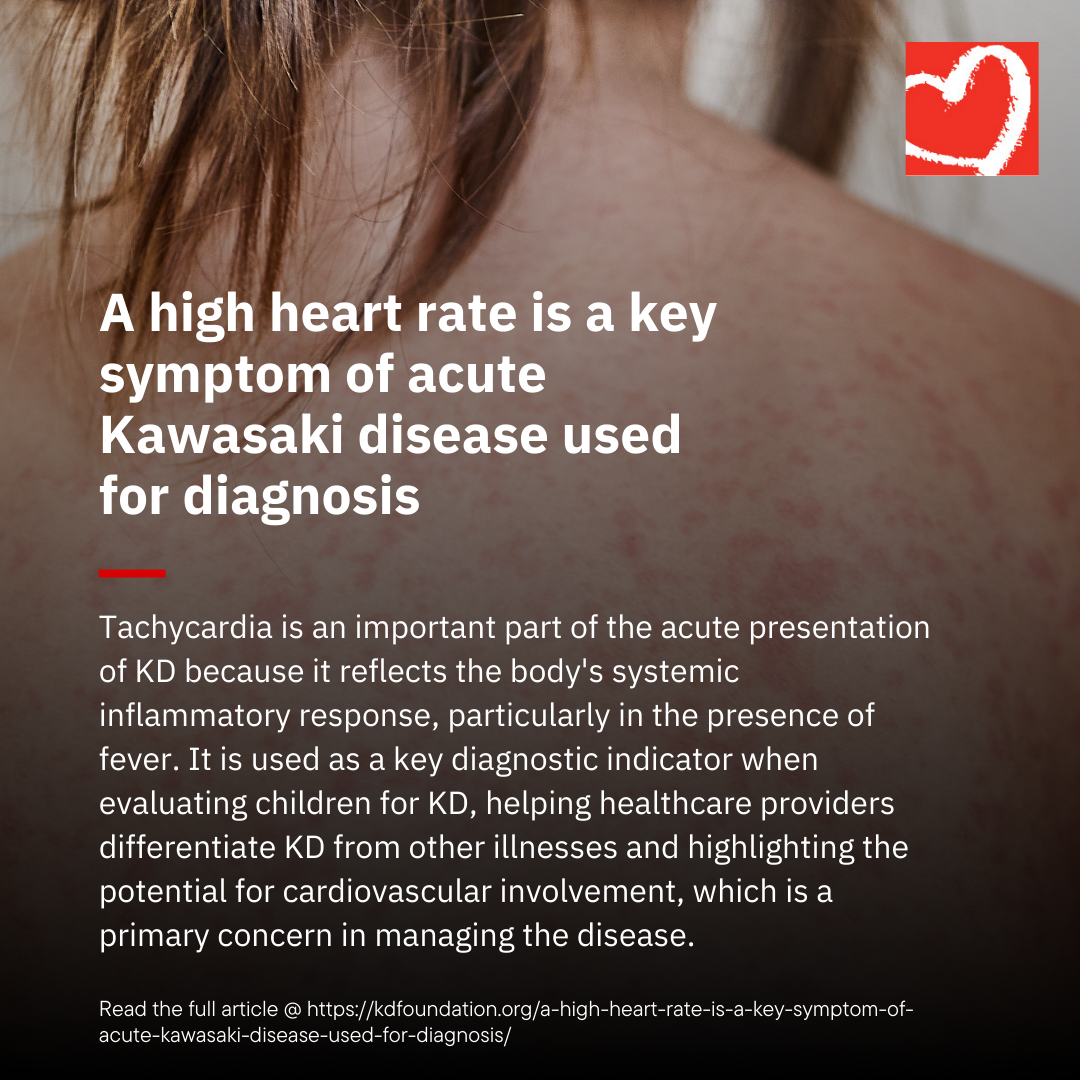
A high heart rate is a key symptom of acute Kawasaki disease used for diagnosis
A high heart rate, or tachycardia, is a key symptom observed in the acute phase of Kawasaki disease (KD) and plays a crucial role in the diagnostic process. Here’s why tachycardia is part of the acute presentation of KD and how it is used when considering a diagnosis:
1. Why High Heart Rate is Part of the Acute Presentation of Kawasaki Disease:
- Systemic Inflammation: Kawasaki disease is a systemic inflammatory condition that causes inflammation of the blood vessels, particularly the coronary arteries. This inflammation leads to a hyperactive immune response, which affects multiple organs, including the heart. The increased inflammation often results in a higher metabolic demand, which in turn causes the heart to pump faster to maintain adequate oxygen delivery to the body’s tissues.
- Fever: One of the hallmark symptoms of Kawasaki disease is persistent fever, typically lasting more than five days. Fever itself often leads to an elevated heart rate as the body attempts to fight the infection or underlying inflammatory process. In KD, fever is often the trigger for the increased heart rate, but this tachycardia is also due to the body’s inflammatory response to the disease.
- Acute Phase Response: During the acute phase of KD, the heart rate is commonly elevated as part of the body’s response to systemic vasculitis (inflammation of the blood vessels). The tachycardia is a response to the inflammatory cytokines, which increase the heart’s workload, particularly in children whose metabolic rate is already high due to the fever and inflammation.
Sources:
- According to the American Heart Association (AHA), a high heart rate is commonly seen in children with KD, particularly during the acute phase of the disease due to fever and inflammation (AHA, 2021).
- The Journal of Pediatrics mentions that tachycardia is one of the early symptoms of KD, which is noted alongside other clinical signs like fever, rash, and conjunctival injection (AAP, 2020).
2. How Tachycardia is Used in the Diagnostic Process for Kawasaki Disease:
- Clinical Presentation: Kawasaki disease is a clinical diagnosis, meaning it is primarily diagnosed based on the clinical signs and symptoms a patient presents with. The high heart rate (tachycardia) is often one of the first symptoms that doctors notice when evaluating a child with a persistent fever and suspected KD. Tachycardia, alongside other symptoms like conjunctival injection (red eyes), rash, and swollen hands or feet, helps clinicians form a diagnosis.
- Differential Diagnosis: Tachycardia is one of the factors that distinguishes Kawasaki disease from other febrile illnesses. In cases of fever due to infection (such as viral infections), tachycardia is also present, but in KD, it is accompanied by other specific clinical features, such as red, cracked lips, a strawberry tongue, and lymph node swelling.
- Risk of Complications: The high heart rate in KD is also closely monitored because it can indicate cardiovascular involvement. KD can lead to serious heart complications, including coronary artery aneurysms, which can lead to a long-term risk for heart attack or stroke in severe cases. Tachycardia is an important clinical sign to observe in the early stages, as it helps alert doctors to potential cardiac complications, prompting earlier diagnostic tests, such as echocardiography and electrocardiograms (ECG).
Sources:
- The Kawasaki Disease Foundation notes that tachycardia is commonly seen during the acute phase of KD due to systemic inflammation and fever, which contributes to the overall diagnostic picture (KDF, 2021).
- The Mayo Clinic and National Institutes of Health (NIH) both emphasize that tachycardia is part of the clinical evaluation for KD, as it helps differentiate this disease from other febrile illnesses in children (Mayo Clinic, 2021; NIH, 2021).
- The American Heart Association (AHA) also highlights that tachycardia can be an indicator of the severity of inflammation, which plays a role in evaluating the disease’s progression and possible cardiac risks (AHA, 2021).
Conclusion:
Tachycardia is an important part of the acute presentation of Kawasaki disease because it reflects the body’s systemic inflammatory response, particularly in the presence of fever. It is used as a key diagnostic indicator when evaluating children for Kawasaki disease, helping healthcare providers differentiate KD from other illnesses and highlighting the potential for cardiovascular involvement, which is a primary concern in managing the disease.
